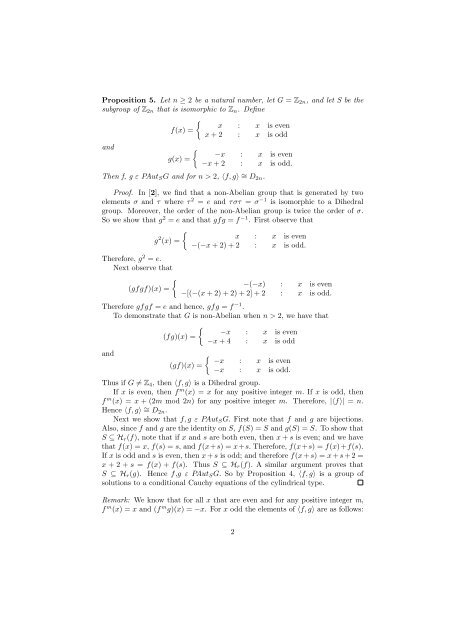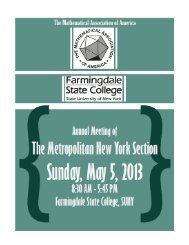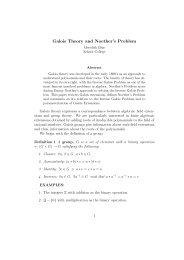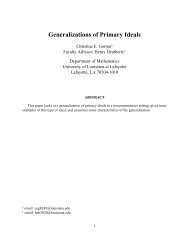A New Representation of the Dihedral Groups - MAA Sections
A New Representation of the Dihedral Groups - MAA Sections
A New Representation of the Dihedral Groups - MAA Sections
Create successful ePaper yourself
Turn your PDF publications into a flip-book with our unique Google optimized e-Paper software.
Proposition 5. Let n ≥ 2 be a natural number, let G = Z 2n , and let S be <strong>the</strong><br />
subgroup <strong>of</strong> Z 2n that is isomorphic to Z n . Define<br />
{<br />
x : x is even<br />
f(x) =<br />
x + 2 : x is odd<br />
and<br />
{<br />
g(x) =<br />
−x : x is even<br />
−x + 2 : x is odd.<br />
Then f, g ε PAut S G and for n > 2, 〈f, g〉 ∼ = D 2n .<br />
Pro<strong>of</strong>. In [2], we find that a non-Abelian group that is generated by two<br />
elements σ and τ where τ 2 = e and τστ = σ −1 is isomorphic to a <strong>Dihedral</strong><br />
group. Moreover, <strong>the</strong> order <strong>of</strong> <strong>the</strong> non-Abelian group is twice <strong>the</strong> order <strong>of</strong> σ.<br />
So we show that g 2 = e and that gfg = f −1 . First observe that<br />
{<br />
g 2 (x) =<br />
Therefore, g 2 = e.<br />
Next observe that<br />
{<br />
(gfgf)(x) =<br />
x : x is even<br />
−(−x + 2) + 2 : x is odd.<br />
−(−x) : x is even<br />
−[(−(x + 2) + 2) + 2] + 2 : x is odd.<br />
Therefore gfgf = e and hence, gfg = f −1 .<br />
To demonstrate that G is non-Abelian when n > 2, we have that<br />
{<br />
−x : x is even<br />
(fg)(x) =<br />
−x + 4 : x is odd<br />
and<br />
(gf)(x) =<br />
{ −x : x is even<br />
−x : x is odd.<br />
Thus if G ≠ Z 4 , <strong>the</strong>n 〈f, g〉 is a <strong>Dihedral</strong> group.<br />
If x is even, <strong>the</strong>n f m (x) = x for any positive integer m. If x is odd, <strong>the</strong>n<br />
f m (x) = x + (2m mod 2n) for any positive integer m. Therefore, |〈f〉| = n.<br />
Hence 〈f, g〉 ∼ = D 2n .<br />
Next we show that f, g ε PAut S G. First note that f and g are bijections.<br />
Also, since f and g are <strong>the</strong> identity on S, f(S) = S and g(S) = S. To show that<br />
S ⊆ H r (f), note that if x and s are both even, <strong>the</strong>n x + s is even; and we have<br />
that f(x) = x, f(s) = s, and f(x+s) = x+s. Therefore, f(x+s) = f(x)+f(s).<br />
If x is odd and s is even, <strong>the</strong>n x + s is odd; and <strong>the</strong>refore f(x + s) = x + s + 2 =<br />
x + 2 + s = f(x) + f(s). Thus S ⊆ H r (f). A similar argument proves that<br />
S ⊆ H r (g). Hence f,g ε PAut S G. So by Proposition 4, 〈f, g〉 is a group <strong>of</strong><br />
solutions to a conditional Cauchy equations <strong>of</strong> <strong>the</strong> cylindrical type.<br />
Remark: We know that for all x that are even and for any positive integer m,<br />
f m (x) = x and (f m g)(x) = −x. For x odd <strong>the</strong> elements <strong>of</strong> 〈f, g〉 are as follows:<br />
2
















